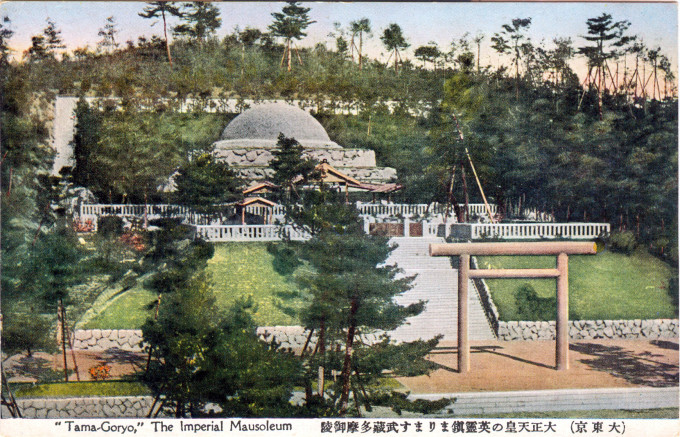See also:
Meiji Jingu (Shrine)
“Yoshihito was born August 31 1879, the son of Emperor Mutsuhito and his concubine, Yanagiwara Naruko. He was later adopted by the Empress and became the official heir to the throne. In May 1900, he married Sadako Kujō and the couple had four sons. He succeeded his father, Mutsuhito (posthumous name, Meiji), as Emperor on July 30 1912. Yoshihito’s reigning period, from 1912-1926, became known as the Taisho era.
“Beginning with Emperor Taisho, who died on December 25 1926, Japan’s emperors have been buried at the Musashino Imperial Mausoleum, near Hachiōji in western, suburban Tokyo. Prior to that, from 1629 through 1867, the traditional burial site of the rulers of Japan was the Sennyū-ji Temple complex in Kyoto.
“Emperior Meiji was given his own dedicated mausoleum in Tokyo, Meiji Jingu, after his passing in 1912. The Hachiōji site presently contains the mausolea of Emperor Taishō, Empress Teimei, the Shōwa Emperor (who reigned 1926-1989), and Empress Kōjun.
“In 2012 and 2013, the Imperial Household Agency confirmed press reports that then-Emperor Akihito and Empress Michiko did not plan to be buried like their immediate predecessors, but to be cremated, for which cremation facilities will be added to the Musashi Imperial Graveyard. Their ashes will then be interred in individual mausoleums, to be built side by side in an integrated fashion, on the west side of the tomb of Emperor Taishō.
“This adaptation of the imperial funeral rites will mark a historic change from some 350 years in which in-ground burials were the norm for monarchs and their spouses.”
– Wikipedia




Pingback: Crown Prince Yoshihito (Taisho) and family, c. 1910. | Old TokyoOld Tokyo